Several of the results will be compared to those from the previous ESL tournaments. There are several reasons why the results differ:
- This is the first bigger tournament after the significant patch from the 21st of June.
- It was found that faction, map and commander choices differ from player to player. However, several of the more prominent players of the ESL series that contributed a lot of games to the database (Jove, Luvnest, Paul.a.D, Shadowada, HelpingHans to name a few) got eliminated early.
- The ESL series was played over three months over which the meta partially shifted. In addition, the weekly cups often were not overly relevant in terms of prize money so players potentially were more open to experiment.
The Data
The series consisted of two qualifier rounds and the main event which itself stretched over several weeks. In order to get a decent amount of games, all data from all available rounds was used.
Data was collected in one of three ways:
- Downloading the player's history from Relic's servers: With 191 games this is the most complete list. Potentially, a few (less than five) games might be missing from the initial rounds; the brackets on battlefy do not indicate if a round was won by default so it is hard to verify if the games actually happened. The data contain factions, map, game length and who won.
- Replays: 117 replays are available. These are used to derive information about commander picks and loadouts as well as build orders and teching choices.
- Casts: The replays are augmented by commander data taken from nine live casts for which no replay was available.
The average game length was 27 minutes. The most damage in a single game (97,702) was done by BartonPL in a 64 minute slugfest on Crossing in the Woods against Jesulin.
Maps
The diagram below shows how many games have been played on which map. The most two popular map was Kholodny Ferma (KF) with Faymonville Approach (FA) already a distant second. These two were the most used maps during ESL as well, however there FA was slightly more popular than KF.
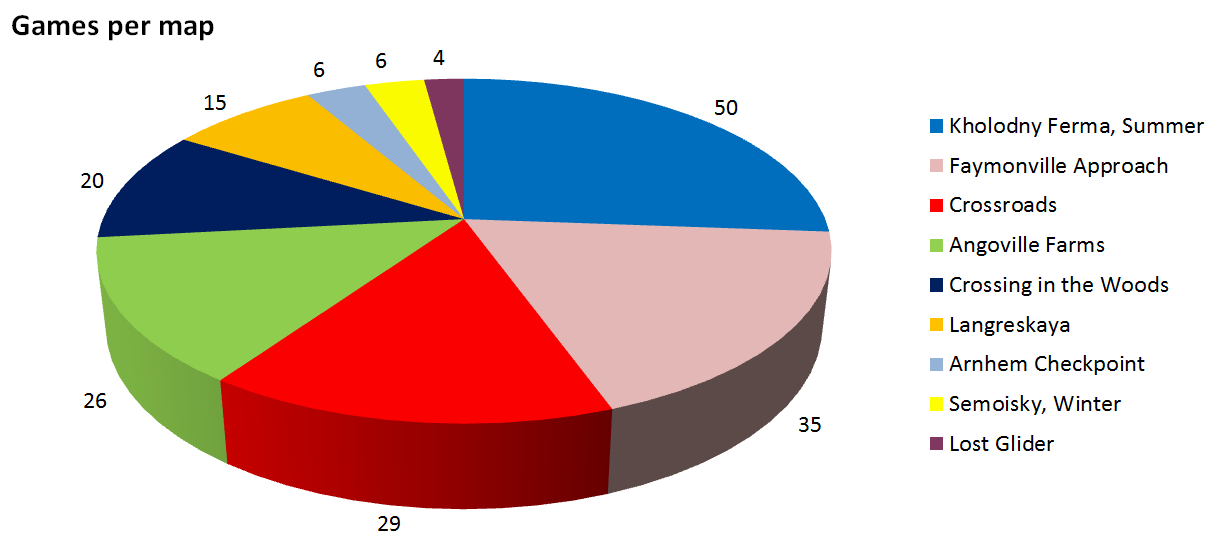
This time there were two new maps in the pool, namely Crossroads and Lost Glider (LG). While Crossroads became the third most played map, LG turned out to be dead last.
In term of game length, the maps are very similar (see below). Langreskaya, notorious for producing lengthy matches ended up on the shorter end of the range of average games lengths. It did, however, also provide the longest match, which was a 66 minute game between Arnolaz and Woodstock.
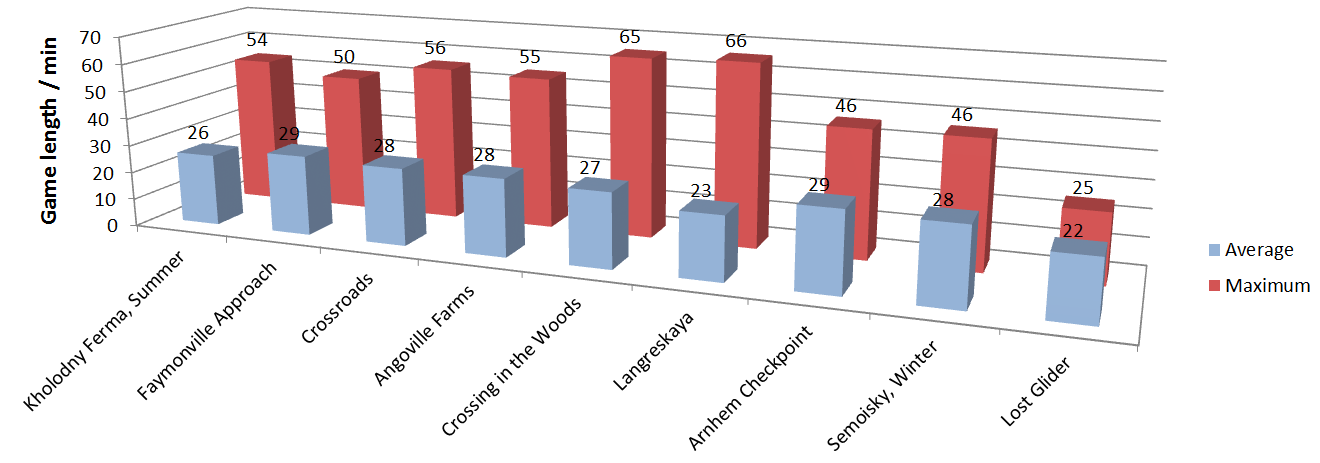
Factions and Matchups
The diagram below shows the faction choice and faction win percentages during the WPC series. On the axis side, the distribution is fairly similar to that during ESL with about 2/3rd OH to 1/3rd OKW. SOV was used more often than USF as well, but the discrepancy is not as pronounced as it was back then. UKF was effectively irrelevant to the tournament as it was used in less then 6% of games.

The win percentages (the hatched areas indicate an estimate of the uncertainty), show OH, OKW and UKF won significantly less than 50% of their games. SOV is slightly higher than 50% while USF is at around 75%.
To break this down further, the next diagram shows the stats per matchup. The win percentage is that of the axis faction in the matchup. OKW/UKF was omitted as this matchup occurred only twice, with the factions winning one game each.

The win percentages demonstrate that the OH/SOV matchup is reasonably well balanced. USF, however, dominates both OKW and OH by a margin. The numbers might indicate that OKW is doing slightly better than OH here, although the range of error estimates overlap. OKW is also doing poorly vs. SOV, resulting in the overall worse win percentage compared with OH.
UKF seems to be the only allied faction that is doing poorly against OH.
Matchups and Maps
The charts in this section show number of games per matchup and map. The blue bars indicate the number of games and the red bars denote how many of those were won by the axis faction. Diagrams for UKF matchups are omitted due to the low number of games. Still, even for the other matches, sample sizes are small and at best might indicate general trends.
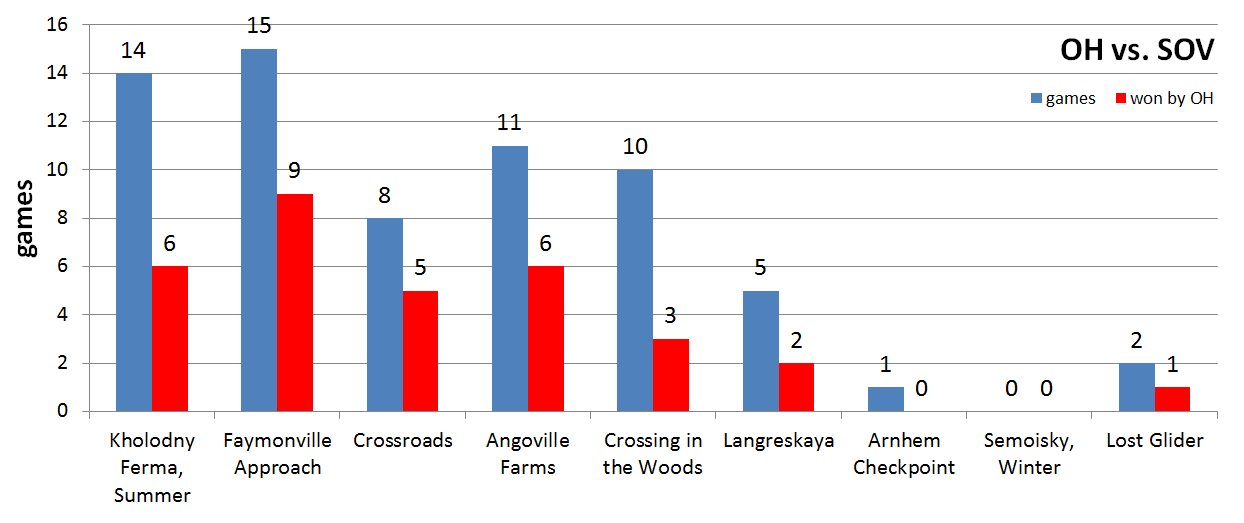
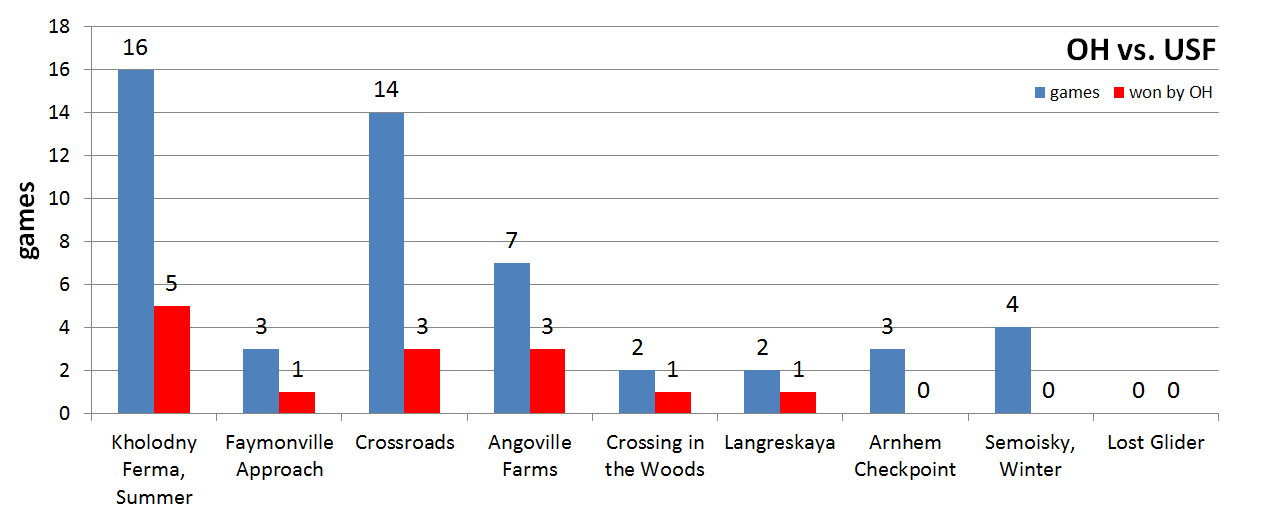
OH did reasonably well against SOV on FA and Crossroads and Angoville. The faction was not as successful on KF, as well as Crossing and Langreskaya, the latter two being generally considered favourable for OH. Results vs. USF are poor regardless of the map.
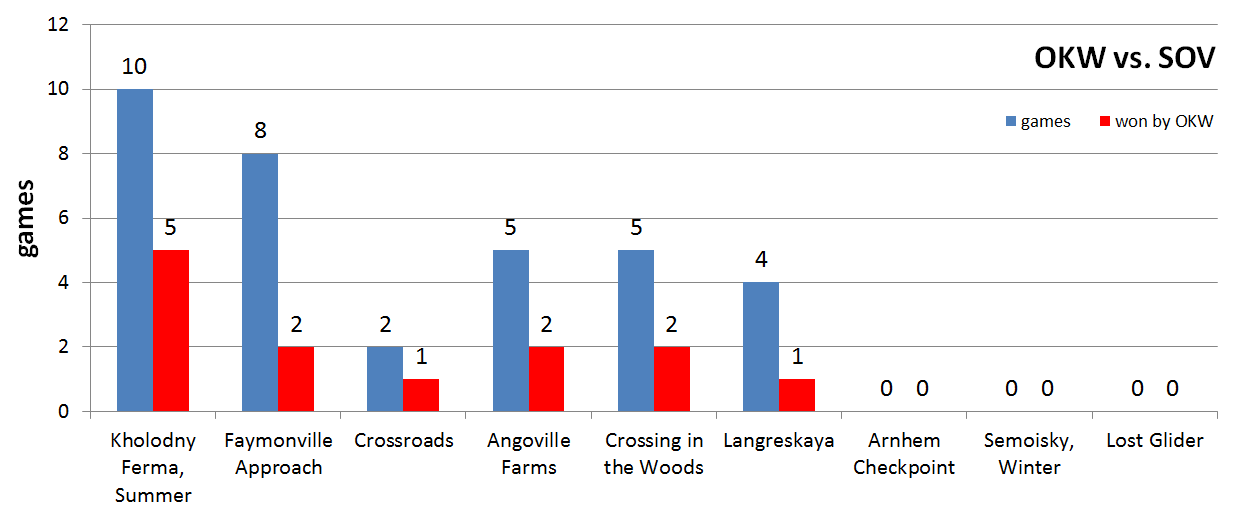
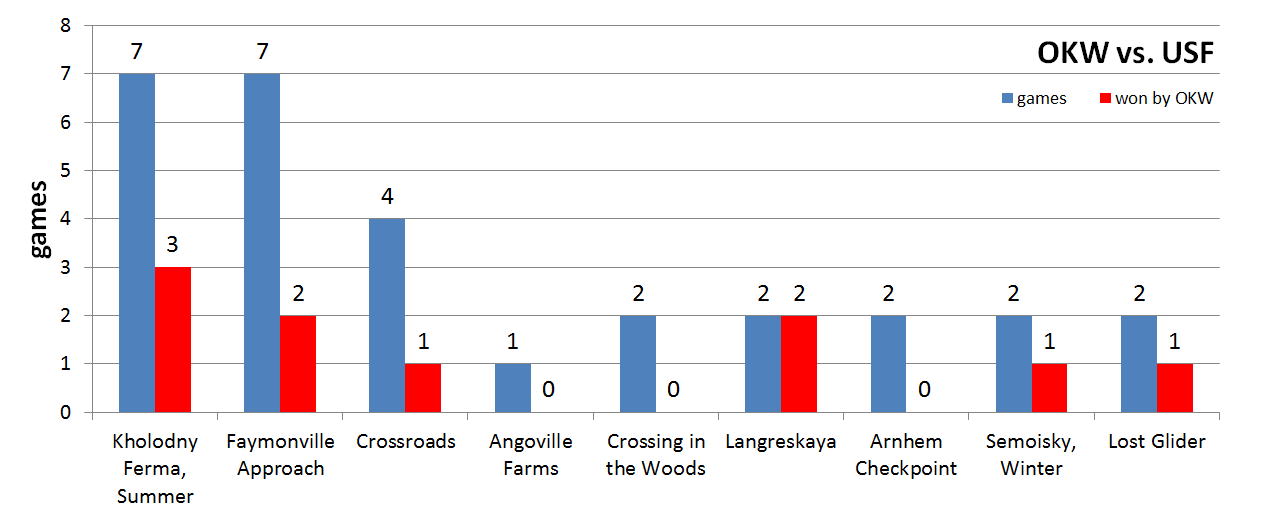
OKW seems to hold its own reasonably well on KF but not so much on FA.
Game Length per Faction
The graphs in this section show how long the games lasted, when games were won or lost and when the commanders are picked. The data is binned into three minute windows for the commander choice and six minutes for everything else.
Specifically, the lines mean:
| green line | games won within that time bin as percentage of games won |
| red line | games lost within that time bin as percentage of games lost |
| blue line | percentage of games still going on in that time bin |
| black, dashed line | percentage of games in which a commander was picked until the end of the time bin |
The latter is derived from the 117 replays. No diagram is shown for UKF as there are simply not enough games available to create meaningful diagrams.
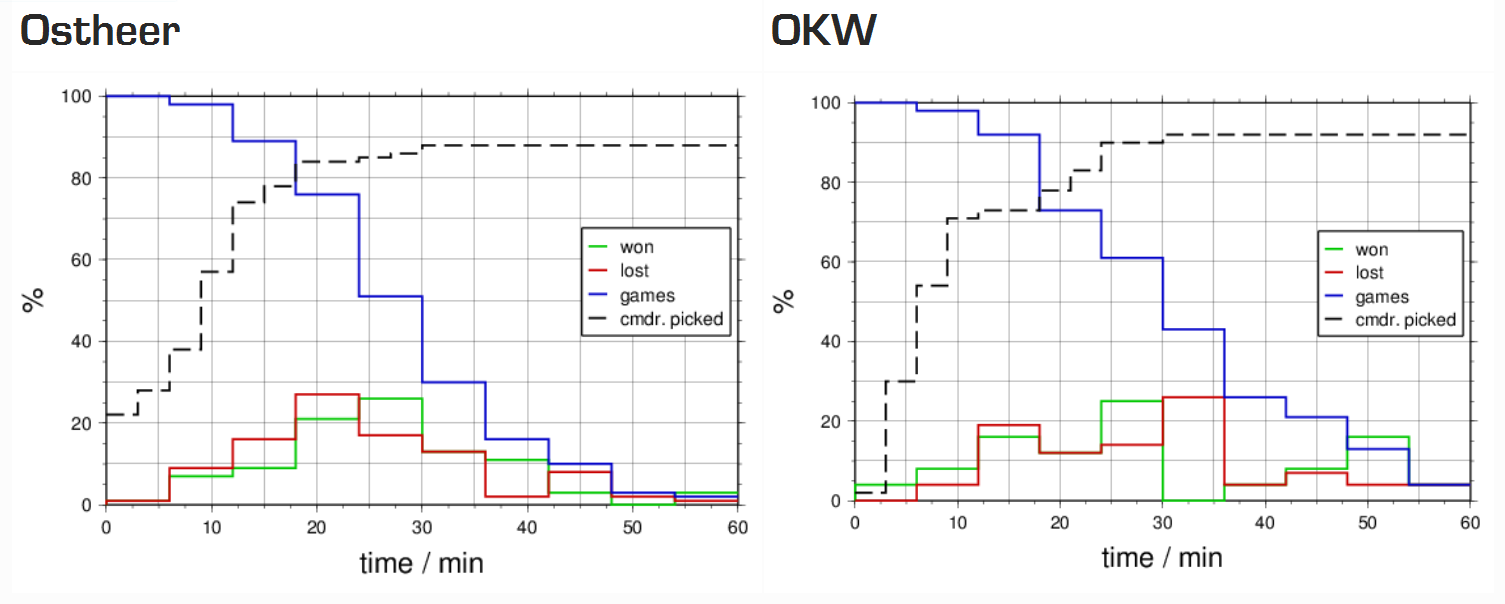
 ostheer Ostheer
ostheer Ostheer  ostheer
ostheerThe strongest interval for OH seems to be at about 24-30 minutes in which about 27% of the faction's victorious games are won. Most games are lost in the time interval just before that in minute 18 to 24. Either way, 70% of games end in the first 30 minutes. Only 10% of OH games lasted longer than 42 minutes.
In about 40% of the cases, commanders were picked by minute nine. In the next six minutes, the percentage jumps to almost 80%. This might be related to the appearance of opposing light vehicles which dictate commander choices.
 okw OKW
okw OKW  okw
okwA few OKW players insta-picked a commander, but after six minutes that black curve is not too different to the OH one. OKW manages to secure a couple of wins in the first few minutes. The strongest phase is minutes 24 to 30, but there is no win for OKW on record between 30 and 36 minutes. The ultra-late-game strength of OKW shows itself in another bump in the winning curve at around 50 minutes. Likewise, OKW games tend to last longer than for other factions with more than 20% of games lasting longer than 42 minutes.
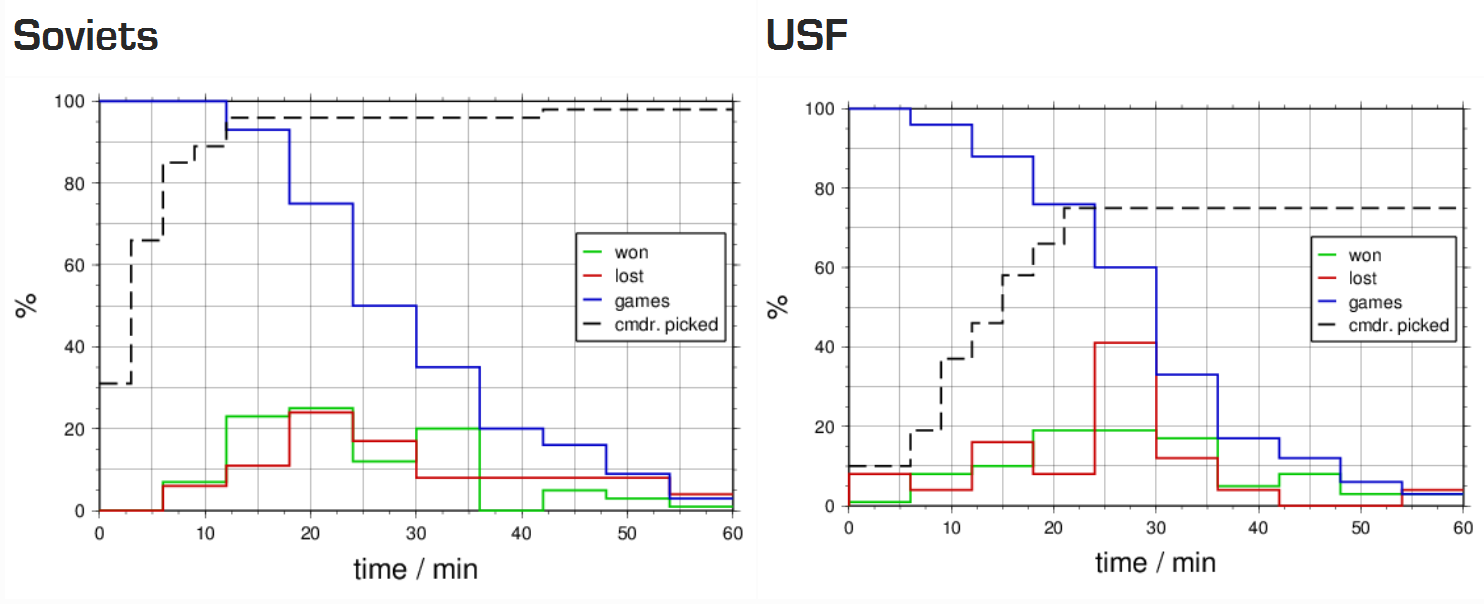
 soviets Soviets
soviets Soviets  soviets
sovietsThe SOV curves shows that no game involving this faction ended before minute six. The interval in which most SOV games were won is at 12th to 18th minute (likely the T-70 effect), while most losses are just past that; maybe those are games were the T-70 failed to make much of an impression. Once the game reached 36 minutes, SOV wins become scarce.
Commanders are picked very early, with 95% picked at the 12 minute mark. This is likely related to commander abilities like Radio intercept and Guards.
 usf USF
usf USF  usf
usfThe curves for USF are surprisingly similar to those of OH. The main difference to all other factions is that the commanders are picked rather late (reaching 50% by 15 minutes) and often no commander is picked at all.
A few number of games as USF have been lost in the first few minutes. Most games are won in the 18-24 bracket, but maximum is rather flat up until 36 minutes. A lot of games, however, have been lost in the 24 to 30 minute window. But even past 36 minutes, USF doesn't appear to be weaker than OH.



 wouren
wouren 



 cblanco ★
cblanco ★  보드카 중대
보드카 중대  VonManteuffel
VonManteuffel  Heartless Jäger
Heartless Jäger 